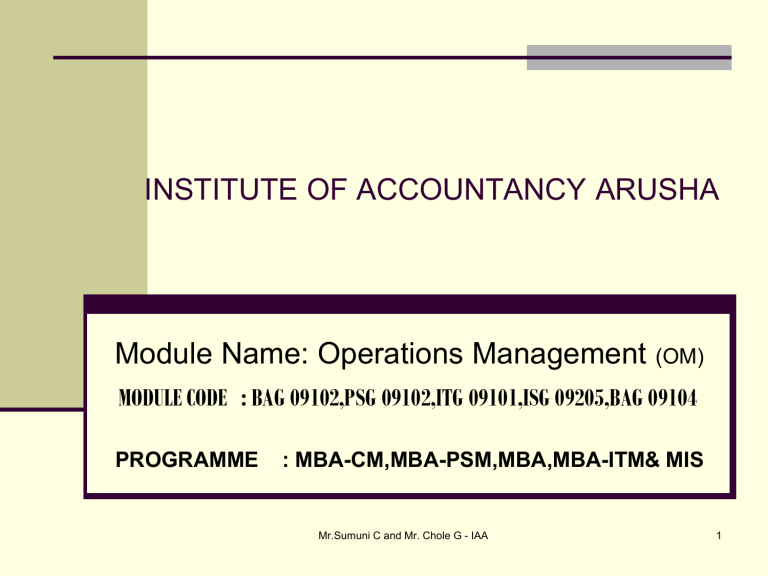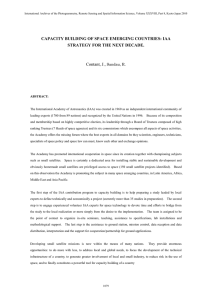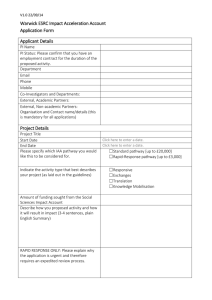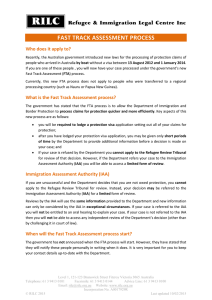
INSTITUTE OF ACCOUNTANCY ARUSHA Module Name: Operations Management (OM) MODULE CODE : BAG 09102,PSG 09102,ITG 09101,ISG 09205,BAG 09104 PROGRAMME : MBA-CM,MBA-PSM,MBA,MBA-ITM& MIS Mr.Sumuni C and Mr. Chole G - IAA 1 ASSESSMENT and EVALUATION: A. Continuous Assessments is 50% which will comprise: Assignment 1 Term Paper Assignment Group Assignment Total B. Semester Exam TOTAL( A+B) 15% 20% 15% 50% 50% 100% Mr.Sumuni C and Mr. Chole G - IAA 2 Major Topics: This Module will cover the following Topics Introduction to Operations Management Designing of Business Operations Operations Management(OM) and Control Operations Quality Management Mr.Sumuni C and Mr. Chole G - IAA 3 Topic One Introduction to Production and Operations Management Mr.Sumuni C and Mr. Chole G - IAA 4 Introduction: An Organization as an economic entity produces goods and services for its existence. It is the output which justifies the existence of the organization. Production is creation of goods and services (through conversion). Mr.Sumuni C and Mr. Chole G - IAA 5 Cont.. The Input- Process -Output Model of an organization can be used to Describe an organization and define what is Operations Management and build the essence of value addition. Mr.Sumuni C and Mr. Chole G - IAA 6 The Input- Process- Output Model (Value-Added Process) The operations function involves the conversion of inputs into outputs Value added Inputs: Land Labor Capital Transformation/ Conversion process Outputs: Goods Services Feedback Control Feedback 10 Feedback Mr.Sumuni C and Mr. Chole G - IAA . Traditionally: In manufacturing , the transformation is tangible(E.g:Automobile/pharmaceutical),usually referred as Production. Where as in Service sector (Eg: Teaching / Counseling), the transformation is usually intangible and referred as Operation. Mr.Sumuni C and Mr. Chole G - IAA 8 Cont... However, regardless of whether the end product is a good or service, the production activities that go in the organizations are often viewed as a set of operations and thus, referred to as Operations. Managing the Operations in line with the stated/implied organizational objectives forms the basis for Operations Management(OM). Hence: Operations Management refers to the generation of goods and services, Mr.Sumuni the set of value-added activities that C and Mr. Chole G - IAA 9 transform inputs into outputs. Cont.… The nature of Operations Management(OM)is the management of processes or systems that create good and/or provide services. The organization need to manage all the conversional activities which represent the process. The heart of POM is the management of production systems where the firm need to make number of decisions with regards to the product. Mr.Sumuni C and Mr. Chole G - IAA 10 Cont.... A Production / Operations System as defined above, is a system which uses operations resources to transform inputs into desired output. Product’s attributes which are subject to company’s decisions include: Product Quality, Product features, Product style/ design, Brand decisions ,Packaging & New product decisions Mr.Sumuni C and Mr. Chole G - IAA 11 OPERATIONS MANAGEMENT (OM) Operations Management (OM) is the set of activities that creates value in the form of goods and services by transforming inputs into outputs. Technically, OM can also be defined as: The function responsible for planning, coordinating, and controlling the resources needed to produce a company’s products and/or services. The transformation includes Physical (manufacturing) , Locational(transport/storage),Exchange(retail),Physiologic al (healthcare) ,Psychological (entertainment) and Informational (communications Mr.Sumuni C and Mr. Chole G - IAA 12 Significant Events in Operations Management Mr.Sumuni C and Mr. Chole G - IAA 13 New Trends in OM Past Causes Future Local or national focus Low-cost, reliable worldwide communication and transportation networks Global focus Batch (large) shipments Short product life cycles and cost of capital put pressure on reducing inventory Just-in-time shipments Low-bid purchasing Quality emphasis requires that suppliers be engaged in product improvement Supplychain partners, Enterprise Resource Planning, e-commerce Mr.Sumuni C and Mr. Chole G - IAA 14 New Trends in OM Past Lengthy product development Standardized products Job specialization Causes Shorter life cycles, Internet, rapid international communication, computeraided design, and international collaboration Affluence and worldwide markets; increasingly flexible production processes Changing socioculture milieu; increasingly a knowledge and information society Mr.Sumuni C and Mr. Chole G - IAA Future Rapid product development, alliances, collaborative designs Mass customization with added emphasis on quality Empowered employees, teams, and lean production 15 New Trends in OM Past Low-cost focus Causes Environmental issues, ISO 14000, increasing disposal costs Mr.Sumuni C and Mr. Chole G - IAA Future Environmentally sensitive production, green manufacturing, recycled materials, remanufacturing 16 TODAY’S POM ENVIRONMENT Customers demand better quality, greater speed, and lower costs Companies implementing lean systems concepts – a total systems approach to efficient operations Recognized need to better manage information using ERP and CRM systems Increased cross-functional decision making Mr.Sumuni C and Mr. Chole G - IAA 17 POM IN GOODS AND SERVICES Based on the nature, the products can be classified into goods and services. It is important to understand the relative goodsservice mix in the output, Depending on the conceptualization of the market offering. It becomes practically difficult to offer ‘pure good’ or ‘pure service’. More realistic is to classify the different products on a continuum. Mr.Sumuni C and Mr. Chole G - IAA 18 Goods and Services Automobile Computer Installed carpeting Fast-food meal Restaurant meal/auto repair Hospital care Advertising agency/ investment management Consulting service/ teaching Counseling 100% 75 50 25 0 25 50 75 100% | | | | | | | | | Percent of Product that is a Good Percent of Product that is a Service Mr.Sumuni C and Mr. Chole G - IAA 19 BY-PRODUCTS A by-product is a secondary or incidental product deriving from a manufacturing process, and is not the primary product or service being produced. A by-product can be useful and marketable, or it can have negative ecological impact. Feathers - from poultry processing Whey - from cheese manufacturing Acidulated soap stock - from the refining of vegetable oil Glycerol - from the production of biodiesel Mr.Sumuni C and Mr. Chole G - IAA 20 POM AS PART OF MANAGEMENT FUNCTIONS It is a management function It’s directly linked to the organization’s strategy It involves managerial decisions for different planning-horizons Long-term, medium-term, short-term It is organization’s core function Like marketing, finance, HRM, etc. Every organization, irrespective of nature, has OM function Service or Manufacturing For profit or Not for profit, etc. Mr.Sumuni C and Mr. Chole G - IAA 21 POM ACROSS THE ORGANIZATION Most businesses are supported by the functions of operations, marketing, finance and HRM The major functional areas must interact with each other to achieve the organization goals; Marketing is not fully capable of meeting customer needs if they do not understand what operations can produce Finance cannot judge the need for capital investments if they do not understand operations concepts and needs. Mr.Sumuni C and Mr. Chole G - IAA 22 Roles of Operations Managers(OM Decisions) All good managers perform the basic functions of the management process. The management process consists of planning, organizing, staffing, leading, and controlling. Operations managers apply this management process to the decisions they make in the OM function. Mr.Sumuni C and Mr. Chole G - IAA 23 Cont..... Design of goods and services What good or service should we offer? How should we design these products and services? Managing quality How do we define quality? Who is responsible for quality? Process and capacity design What process and what capacity will these products require? What equipment and technology is necessary for these processes? Mr.Sumuni C and Mr. Chole G - IAA 24 OM Decisions................ Location strategy Where should we put the facility? On what criteria should we base the location decision? Layout strategy How should we arrange the facility? How large must the facility be to meet our plan? Human resources and job design How do we provide a reasonable work environment? How much can we expect our employees to produce? Mr.Sumuni C and Mr. Chole G - IAA 25 Cont.…. Reliability Management: This is the procedure for keeping the operating facility (equipment, machinery and buildings) in optimal operating condition in order to achieve their optimal economic lives. Inventory Management: Optimal levels of input materials, work in progress and finished goods has to be maintained in order to achieve smooth flow of operations to minimize overall operating costs. Mr.Sumuni C and Mr. Chole G - IAA 26 Why Operations Management OM is one of the three major functions of any organisations, and it is integrally related to all the other business functions. All organisations market (sell), finance (account), and produce (operate), and it is important to know how the OM segment functions. i. Therefore, we study OM in order to know how people organise themselves for productive enterprise. Mr.Sumuni C and Mr. Chole G - IAA 27 Cont.…. ii. iii. We study OM because we want to know how goods and services are produced. The production function is the segment of our society that creates the products we use. We study OM to understand what production/operations managers do Mr.Sumuni C and Mr. Chole G - IAA 28 Cont.. iv. We study OM/POM because it is such a costly part of an organisation. A large percentage of the revenue of most firms is spent in the POM function. v. OM decisions are strategic decisions and once made it is not possible to revise them without incurring major costs Mr.Sumuni C and Mr. Chole G - IAA 29 Cont.…. vi. Many worker we supervise and make decisions about them are employees in OM function. E.g. Over 18 million workers in US are in manufacturing jobs and accounts for over 70% of value of U.S. exports. Mr.Sumuni C and Mr. Chole G - IAA 30 INTERELATION OF OM AND OTHER FUNCTIONS IN ORGANIZATION Information systems enables the information flow throughout the organization Human resources must understand job requirements and worker skills Accounting needs to consider inventory management, capacity information, and labor standards Mr.Sumuni C and Mr. Chole G - IAA 31 Productivity Productivity is the ratio of outputs (goods and services) divided by the inputs (resources such as labor and capital) The objective is to improve this measure of efficiency Important Note! Production is a measure of output only and not a measure of efficiency Mr.Sumuni C and Mr. Chole G - IAA 32 Productivity Productivity = Units produced Input used Measure of process improvement Represents output relative to input Only through productivity increases can our standard of living improve Mr.Sumuni C and Mr. Chole G - IAA 33 Single Resource Productivity Labor Productivity Units produced Productivity = Labor-hours used = 1,000 250 = 4 units/labor-hour Mr.Sumuni C and Mr. Chole G - IAA 34 Multi-Factor Productivity Productivity = Output Labor + Material + Energy + Capital + Miscellaneous Also known as total factor productivity Output and inputs are often expressed in dollars Mr.Sumuni C and Mr. Chole G - IAA 35 Example 1: a. What is Productivity as used in OM? b. A wrapping paper company produced 2,000 rolls of paper one day.Labour cost was$160,material cost was $50 and overhead was$320. Required: Determine the multifactor productivity Mr.Sumuni C and Mr. Chole G - IAA 36 Soln: Quantity Produced@SP Productivity = Labor cost+ Material + Overhead = 2,000 $160+$50+$320 = 3.77rolls per $ Mr.Sumuni C and Mr. Chole G - IAA 37 Example 2: A firm cleans chemical tank cars in the Bay St. Louis area. With standard equipment, the firm typically cleaned 70 chemical tank cars per month. They utilized 10 gallons of solvent, and two employees worked 20 days per month, 8 hours a day. The company decided to switch to a larger cleaning machine. Last April, they cleaned 60 tank cars in only 15 days. They utilized 12 gallons of solvent, and the two employees worked 6 hours a day. 1. What was their productivity with the standard equipment? Mr.Sumuni C and Mr. Chole G - IAA 38 Example………….. 2.What is their productivity machine? with the larger 3. What is the change in productivity? Mr.Sumuni C and Mr. Chole G - IAA 39 THE END End of Session Thank You for Your Perseverance Mr.Sumuni C and Mr. Chole G - IAA 40





